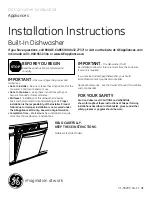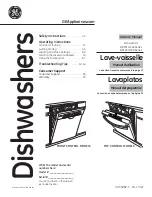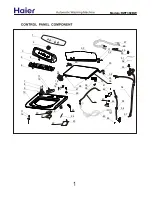
13
Salt loading indicator
This model is provided with an electric light on
the control panel which lights up when it is
necessary to reload the salt container.
Important:
the appearance of white stains on
dishes is generally an important sign that the
salt container needs filling.
Adjustment of the upper
basket
If 27 cm to 31 cm plates are normally used,
load them onto the lower basket after the
upper basket has been placed in its upper
position and proceed as follows:
1) Pull out the upper basket;
2) Then grasp the basket from both sides and
lift it upwards (fig. 20).
Dishes that are bigger than 20 cm in diameter
can no longer be loaded onto the upper basket
and the mobile supports cannot be used when
the basket is in the upper position.
ADJUST BASKET TO THE LOWER
POSITION:
1) Grasp the basket from both sides and lift
slightly upwards (fig. 21a);
2) Then slowly release into the correct position
(fig. 21b) .
N. B. : NEVER LIFT OR LOWER THE
BASKET BY ONE SIDE ONLY (fig.21/1).
Attention :
It is advisable to adjust the basket before
loading the dishes.
Loading dishes
To load dishes
For good wash performance remove any
debris from the dishes (bones, tooth picks, the
remains of meat and vegetables) to avoid
blocking the filters, water outlet and washing
arm nozzles and, as a result, reducing
washing efficiency.
Try not to rinse the dishes before loading them
into the dishwasher.
If saucepans and oven dishes are encrusted
with the remains of burnt or roast food, it is
advisable to leave them to soak before
washing.
Using the upper basket
The upper basket is provided with mobile
racks hooked to the sides of the basket which
can be regulated in two positions: upright and
lowered. In the lowered position the racks may
be used for tea and coffee cups, kitchen kni-
ves and ladles. Glasses with stems may be
safely hung on the ends of the racks.
Glasses, cups, saucers and dessert plates
may be loaded under the racks.
Soup plates and ordinary plates may be loa-
ded with the rack in the upright position.
Plates should be loaded vertically with the
underside of the plate towards the back of the
dishwasher with a space between each plate
to allow water to pass freely.
It is advisable to load plates of the same size
together in order to utilize maximum basket
capacity.
Plates may be loaded in a single row (Fig. 13)
or on both rows (Fig. 14).
It is advisable to load large plates (approx. 27
or more cm) slightly tilted towards the rear to
facilitate introduction of the basket into the
machine.
Salad bowls and plastic bowls may also be
loaded on the upper basket. It is advisable to
block these in place so that the jets of water do
not make them overturn.
The upper basket has been designed to offer
maximum flexibility in use and can be loaded
with up to 24 plates on two rows, up to 30 glas-
ses on five rows or a mixed load.
Using the lower basket
Saucepans, oven dishes, tureens, salad
bowls, lids, serving dishes, dinner plates, soup
plates and ladles can be loaded on the lower
basket.
Place the cutlery in the plastic cutlery holder
with the handles pointing upwards.
Place the cutlery holder on the lower basket
(fig. 15), making sure that the cutlery does not
get in the way of the rotating arms.
12
Closing the door
Place the baskets in the machine.
Make sure that both the spray arms are free to
rotate and are not obstructed by cutlery,
crockery or pans. Close the door, pressing on
it to make sure it is firmly shut.
Water softener unit
Depending on to the source of the supply,
water contains varying amounts of limestone
and minerals which are deposited on the
dishes leaving whitish stains and marks.
The higher the level of these minerals present
in the water, the harder the water is.
The dishwasher is fitted with a water softener
unit which, through the use of special regene-
rating salt, supplies softened water for
washing the dishes. The softener unit can treat
water with a hardness of up to 60°fH (French
grading) or 33°dH (German grading) through
five different settings.
The degree of hardness of your water can be
obtained from your water supply company.
Regulating the water
softener
The table below lists different degrees of water
hardness with the corresponding setting for
the softener unit.
- *The water softener unit is set in the factory
at level 2, as this is suitable for the majority
of users.
If your water is at level 0, you need not use
any regenerating salt, nor need you make
any adjustment, as your water is soft.
According to the degree of hardness of your
water, regulate the softener unit in the fol-
lowing way:
- remove the lower rack. Unscrew and remo-
ve the cap from the salt dispenser located in
the bottom of the tub (Fig. A “1”);
- Turn the selector screw to the required posi-
tion with a screwdriver or a knife.
Loading the salt
The dishwasher is fitted with a softener which
clears the water of lime which could cause
scale and damage the dishwasher.
On the bottom of the machine there is a
container for the salt for regenerating the
softener (Fig. A“1”).
The filter medium of the softening plant must
be reactivated with dishwasher water softener
regenerating salt.
Other types of salt contain small quantities of
insoluble particles which over a long period of
time may affect and deteriorate the softener
performance.
To add salt, unscrew the cap of the container
on the bottom and then refill the container
(fig. 24).
During this operation a little water will
overflow; but keep adding salt until the container
is full. When the container is full, clean the
thread of salt residue and retighten the tap.
If the dishwasher is not required straightaway,
set the Prewash programme so that the salt
solution which has overflowed is discharged
from the washing tank.
The salt dispenser has a capacity of between
1.5 and 1.8 kg and, for efficient use of the
appliance, it should be refilled from time to
time according to the regulation of the water
softener unit.
Important: it is necessary to add water until
the container overflows. Only install the
dishwasher after completely filling the salt
container.
Level
0
1
*2
3
4
Water
hardness
°fH
(French)
0-9
10-30
31-40
41-50
51-60
Water
hardness
°dH
(German)
0-5
6-16
17-22
23-27
28-33
Use of
regene-
rating
salt
NO
YES
YES
YES
YES
Water
softener
setting
FREE
position N.1
position N.2
position N.3
position N.4
N°
of
washes
50
40
30
20
TYPE 1
TYPE 2
Содержание HD 83 M
Страница 1: ...HD 96 M HD 96 M ALU English...
Страница 11: ......
Страница 12: ......
Страница 13: ...03 09 41008458 A Printed in Italy Imprim en Italie EN...































